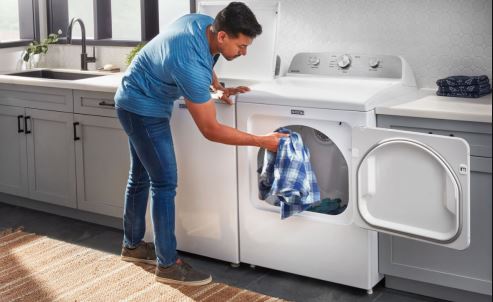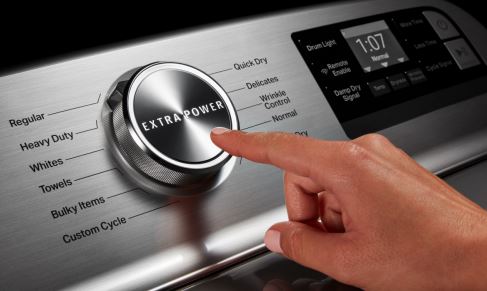Before your Maytag Neptune dryer can dry your wet laundry, it has to get hot. But what if the dryer won’t get hot? How do you explain a Maytag Neptune dryer not heating?
Your Maytag Neptune dryer won’t heat up due to a power supply fault, no-heat setting, poor laundry loading, restricted airflow, burnt heating element, or a damaged thermostat.
While speaking of a power supply fault, we are talking about inadequate voltage directly related to a tripped breaker or blown-up fuse. Meanwhile, we are particular about extra-large or extra-wet laundry when mentioning poor laundry loading.
I’ll explain all those six issues to enable you to quickly identify what’s stopping your Neptune dryer from getting hot and fix it. Additionally, we’ll look at a non-heating Maytag Neptune gas dryer.
Let’s dive in!

In a hurry? Use the table below to quickly troubleshoot your Maytag Neptune dryer when it doesn’t get hot:
Maytag Neptune Dryer Not Heating Properly – Quick Troubleshooting Guide
| – | Likely Issue | Quick Fix |
| 1. | Power Supply Fault | If the collective voltage supply is less than 120V, check for a tripped breaker and reset it or a blown-up fuse and replace it. Call a pro if it’s more than 120V but less than 240V |
| 2. | No-Heat Setting | Deactivate Air Fluff or any other no-heat setting |
| 3. | Poor laundry Loading | Avoid overloading the dryer or clothes that are soaking wet. |
| 4. | Restricted Airflow | Clean the lint screen if clogged, and unblock a blocked exhaust vent. |
| 5. | Burnt Heating Element | Replace a defective heating element (if it fails the continuity test) |
| 6. | Damaged Thermostat | Replace the cycling or hi-limit thermostat if it’s damaged. |
Why is My Maytag Neptune Dryer Not Heating?
Your Maytag Neptune dryer won’t get hot for different reasons. The commonest ones include the following six:
1. Power Supply Fault
Without an adequate power supply, your Maytag Neptune dryer won’t start; if it won’t, you cannot expect it to heat up. In most cases, it’s an issue of insufficient voltage.
Ideally, your dryer’s total voltage supply should be 240V Ac. If it’s less than that, the dryer won’t get hot; in most cases, the breaker trips, or the thermal fuse blows up.
Fix
Use a multimeter to measure the power plug’s voltage supply. If the value is less than 120V, check for a tripped breaker or blown-up fuse. In the case of a tripped breaker, reset it, but if the thermal fuse is blown-up, replace it.
However, call a professional if the total voltage is more than 120V but less than 240V.
2. No-Heat Setting
Not all Maytag dryer settings promote heating. Some settings, such as Air-Fluff, only allow the dryer to blow room-temperature air, not hot air. As a result, the dryer won’t get hot.
Fix
Deactivate Air Fluff or any other no-heat or low-heat setting and choose the correct heat setting.
3. Poor Laundry Loading
Sometimes the issue is with the load. For example, if the clothes are excessive (more than ¾ full), it may take some time before the dryer can get hot. Similarly, if the clothes are extra wet, the dryer will take longer to get hot or may fail to get hot at all.
Fix
Stop the dryer and reduce the size of the wet load to ¾ full. If the clothes are soaking wet, wring out the excess water. It, however, helps to run the drain cycle while the wet clothes are still in the washer – just before you transfer them to the dryer.

4. Restricted Airflow
Your Neptune dryer needs good air circulation to heat up. If there’s any restriction, it may take forever for the dryer to heat up. And speaking of restricted airflow, it could be in any of these forms:
- Lint screen clogging – The lint screen traps lint and stops it from obstructing the dryer vent. Sometimes, however, the trapped lint clogs the lint screen and interferes with airflow, stopping the dryer from heating up.
- Obstructed – The dryer may also have difficulty heating up if the vent is blocked. That could happen due to any of these issues:
- Clogging – Some lint may get into the vent and block it, which could happen due to excess debris. If that’s the case, the clogging may restrict airflow.
- Kinking – If the dryer vent is abnormally long, it’s likely to develop kinks. Unfortunately, the twists restrict airflow, making it hard for your dryer to get hot.
- Many elbows – If your dryer’s vent has too many elbows or bends, they’ll slow down airflow, making it hard for the dryer to get hot.
- Crashed vent – If the exhaust vent is of low-quality material, it may crash, and when that happens, the crashed vent interferes with airflow, making it hard for the dryer to get hot.
Fix
Use warm soapy water to clean the lint screen if it’s clogged, and wipe it dry before reinstalling it. If the dryer vent is clogged, vacuum it to unblock it, but if it’s kinked, straighten it out to get rid of the folds. Replace the dryer vent, however, if it has many elbows or is crashed.
5. Burnt Maytag Neptune Dryer Heating Element
The heating element’s job is to generate enough heat to heat the circulating air, which dries the clothes. If it’s faulty, which could happen if it’s damaged or burnt, it won’t be able to get the dryer hot.
Fix
Use a multimeter and set it on RX1 to test the heating element’s continuity. If the reading is infinity, the heating element is defective. If so, replace it.
6. Damaged Thermostat
The dryer won’t get hot if the cycling or hi-li thermostat fails.
Let’s start with the cycling thermostat;
The cycling thermostat, which you find in the blower housing, regulates air temperature. If it’s faulty, it cuts off the power supply to the heating element, and if the heating element doesn’t generate any heat, the dryer will stay cold.
Unto the hi-limit thermostat;
The hi-li thermostat protects the dryer from overheating. This thermostat, which you find adjacent to the heating chamber, prevents voltage supply to the heating element when it fails, which means your dryer won’t get hot.
Fix
Test both the cycling thermostat and the hi-limit thermostat with a multimeter. If any of the two thermostats lacks continuity, replace them.
Maytag Neptune Gas Dryer Not Heating Enough
You may need to consider more than the six issues discussed above when dealing with a non-heating Maytag Neptune gas dryer. Such a dryer also requires you to consider these additional issues:
- Failed gas supply – It could be that the Neptune dryer’s gas supply is off or disconnected (perhaps for a pending bill). If so, the gas dryer won’t heat up.
- Damaged igniter – Once the igniter fails, it cannot kindle the gas, which means the dryer won’t get hot.
- Faulty flame sensor – The igniter may glow with a defective flame sensor, but the dryer produces no heat.
- Malfunctioning solenoid – If the solenoid or gas control valve fails, the igniter will glow briefly, but no flame will be produced as the igniter won’t have enough gas supply. In the long run, your dryer won’t get hot.
- Other faulty components – Note that in addition to the above components, a Maytag Neptune gas dryer may fail to get hot enough due to a defective timer or control board. Mark you, this is in addition to components like the cycling and hi-limit thermostat, which I shared earlier.

Fix
Ensure you turn on the gas supply, and if there’s any pending gas bill, clear it. Then use a multimeter to measure the igniter’s resistance, which should be 50-400 ohms. Anything outside this bracket means the igniter is faulty and needs a replacement.
Also, test the flame sensor with a multimeter and set the multimeter to RX1. If the sensor’s reading is above 1, you should replace it as that shows it’s faulty.
However, consider asking for a dryer expert’s help to inspect and replace the timer and control board, as they can be hard to diagnose and replace.
And once you do a replacement, ensure you reset your dryer before you can start using it. The easiest way is to disconnect the dryer from the power for at least 1-5 minutes.
People Also Ask
1. Why Is My Maytag Neptune Dryer Not Producing Heat?
Your Maytag Neptune dryer isn’t producing heat because of a wrong setting, such as Air Fluff, a blown-up fuse, or a tripped power breaker. It could also be that the laundry is excessive or too wet, or the vent or lint is clogged. The vent could also be kinked or crashed or has many elbows.
2. How Can I Fix My Maytag Dryer When It Won’t Heat?
You can fix a Maytag dryer that won’t heat using these steps:
- Check the dryer’s voltage supply to ensure the collective voltage is 240V
- Use a heat setting and deactivate Air Fluff or any other no-heat setting
- Clean the lint screen and unblock the dryer vent
- Don’t overload the dryer, and avoid loading extra wet clothes
- Replace a burnt heating element
- Replace a defective cycling or hi-limit thermostat
3. Why Is My Maytag Dryer Running But Not Heating?
Your Maytag dryer is running but not heating because the load is extra wet or extra large, the lint screen is lint-clogged, the vent is obstructed, or the thermal fuse is faulty. It could also be that the heating element or thermostat is defective.
4. Why Is My Maytag Dryer Not Drying?
Your Maytag Dryer is not drying because it is not heating up. Essentially, that could be a power issue, and so you should ensure your dryer has power. But still, it could be a setting, loading, or airflow issue if that’s not it.
Regarding a setting issue, select a heat setting, not Air-Fluff or any other non-heating setting. As for the load, don’t load clothes that are too wet or overload the dryer. And as for airflow, ensure the lint screen and vent are not obstructed.
Concluding Thought On a Maytag Neptune Dryer Not Heating:
Above are the six issues to consider when your Maytag Neptune dryer won’t get hot. Start by checking the dryer’s power supply to ensure it has enough voltage and the setting to ensure it’s a heat setting.
Then check the laundry loading to ensure you don’t overload or load extra-wet clothes and clear any obstructions on the lint screen or dryer vent. And if the heating element, cycling thermostat, or hi-limit thermostat fails the continuity test, replace it.
